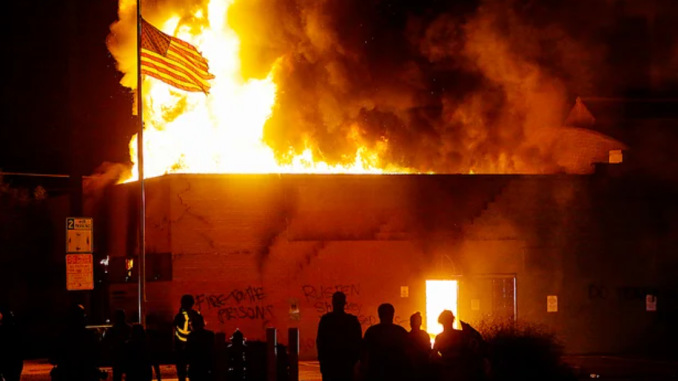
Project 21 co-chair Horace Cooper and former Hennepin County Sheriff Rich Stanek join ‘Fox News @ Night’ to discuss the rise in violent crime across the U.S.
Support of Black Lives Matter and calls to defund the police reverberated across America in 2020 following the death of George Floyd, igniting social justice protests and riots at a time when the coronavirus and lockdowns upended society in unprecedented ways. What was left in 2020’s wake was a massive increase in the number of murders, dealing a disproportionate blow to Black Americans.
“Certainly, the protests and riots mid-2020 after the death of George Floyd followed a pattern of spiking violence that we’ve seen following past viral police incidents, such as the deaths of Michael Brown and Freddie Gray. This pattern has been termed the ‘Ferguson Effect’: police pull back while violent crime spikes precipitously,” Hannah Meyers, director of the policing and public safety initiative at the Manhattan Institute, told Fox News Digital.
Murders across the board spiked by nearly 30% in 2020 compared to the year prior, according to FBI data, marking the largest single-year increase in killings since the agency began tracking the crimes. Among Black Americans, the number of deaths spiked by more than 32% compared to 2019.
In 2019, at least 7,484 Black Americans were murdered. That number shot up to at least 9,941 murders in 2020, meaning there was an increase of 2,457 Black Americans murdered over the previous year.
The number of Black murders was also far higher than White murders in 2020. The FBI data shows there 7,043 White people murdered that year, meaning 2,898 more Black people were killed compared to Whites.
Between 2010 and 2019, there was an average of 5,954 White murders, which is roughly 16% lower than the 10-year average of Black murders. During that same time period, an average of 6,927 Black Americans were murdered each year, meaning Black murders shot up by 43% in 2020 compared to the previous 10-year average.
There was a roughly 21% increase in White murders in 2020 compared to 2019.
The figures are more staggering considering White Americans make up 76% of the population compared to Black Americans representing only 13%, according to Census data.
Murders in the 2010s first broke the 7,000 murder benchmark in 2015 after the high-profile deaths of Freddie Gray that same year and Michael Brown in 2014, jumping by nearly a thousand in one year. Brown was fatally shot by a Ferguson, Missouri, police officer and Gray died after he sustained injuries in the back of a Baltimore police van. Their deaths sparked protests and riots similar to the ones following Floyd’s death.
Prior to Brown’s death, Black murders had fallen the previous four years.
Fox News Digital reviewed murder data from 2014 and 2015 and found a spike of 15% in year over year data. At least 7,000 Black Americans were killed each year thereafter without ever exceeding the 8,000 mark.
St. Louis Police Chief Sam Dotson coined the increase the Ferguson effect in November 2014. The theory gained widespread attention in 2016 after the Manhattan Institute’s Heather Mac Donald wrote an opinion piece for the Wall Street Journal arguing the effect is one “where the Black Lives Matter narrative about racist, homicidal cops has produced virulent hostility in the streets.”
The summer of 2020 was marked by swaths of America pledging support for the Black Lives Matter movement and defunding the police. Many cities answered supporters’ calls by removing portions of police funding, such as Portland and New York City. The social justice movement even trickled down to small cities and spread to nearly every facet of America, stretching from major corporations, celebrities and the sports world demanding change.
Some experts have pinned the cause of the crime spikes on the coronavirus entirely and warned about it at the beginning of the pandemic.
“I’m not surprised at all that we had an increase in crime,” Volkan Topalli, a professor of criminology at Georgia State University, told Politico in 2021 after he became a victim of crime himself. “Criminologists and public health people were saying that that was going to be the case as soon as they heard about the pandemic.”
“The pandemic … revealed something that most of us already knew, which was that we have segments of society that don’t have the advantages of other segments of society,” Topalli said. “They’re just beneath the surface and the pandemic sort of, you know, as with a hurricane … has revealed the disparities.”
A University of California study that estimated more than 100,000 Californians bought guns in 2020 out of fear the pandemic’s destabilizing effects. The study argued that by aggravating “poverty, unemployment, lack of resources, isolation, hopelessness and loss,” the pandemic has “worsened many of the underlying conditions contributing to violence,” the New York Times reported in 2020.
But to Mac Donald, the Ferguson effect played out again in 2020 – with even more swiftness and brutality than before.
2020’s “violent-crime increase—call it Ferguson Effect 2.0 or the Minneapolis Effect— has come on with a speed and magnitude that make Ferguson 1.0 seem tranquil,” Mac Donald wrote during the crime spike that year. “George Floyd’s death at the hands of Minneapolis police in late May was justly condemned — but the event has now spurred an outpouring of contempt against the pillars of law and order that has no precedent in American history.”
Mac Donald told Fox News Digital this month that the Black Lives Matter and the defund the police movements contributed to the crime spike in 2020 and had nothing to do with the coronavirus and lockdowns. The spike “began months after lockdowns beginning only after riots,” noting the “spike was not at all related to COVID.”
The FBI crime data in 2020 came as the FBI switched to a new recording method, the National Incident-Based Reporting System (NIBRS), amid a push to change how law enforcement agencies provide crime figures and record details on every single crime incident.
Murders and nonnegligent manslaughter offenses were already on the rise during the first half of 2020, with FBI data showing a 14.8% increase across the board from January to June.
Murders began to rise in the late winter of 2020 which is typical of that time of year, with the spike appearing to begin in April with 1,261 murders – the month prior to George Floyd’s death. However, April’s numbers were not far off track with April’s numbers in previous years.
May recorded 1,499 murders – which compared to previous Mays is high – before reaching its peak of 1,772 in July, far above July peaks in the previous six years, according to the New York Times citing FBI data. Murders dipped in the month of September to 1,611 before shooting back up to 1,740 in October.
Fox News Digital reached out to the FBI for the data set obtained by the Times to take a closer look, but was told they “do not have the Supplementary Homicide Report File List available at this time.”
Progressive leaders also ushered in criminal justice reforms theoretically intended to rectify the imbalance of Black Americans who are arrested, convicted and incarcerated in response to the social justice uprisings demanding change. But in practice, in cities like New York, these reforms backfired, resulting in a spike in crime, experts say.
“In NY, statewide changes to the bail laws that went into effect in 2020 prevented judges from holding a huge range of defendants in jail pre-trial and effectively prevented judges from considering dangerousness in the decision to set bail. The rate of felony re-offense among defendants out of jail pre-trial who would not have been out of jail prior to “bail reform” has been estimated at 43%. That is a significant number,” Meyers told Fox News Digital in an email.
Meyers and Jim Quinn, a former executive district attorney in the Queens district attorney’s office, published an essay in the New York Times this year arguing that by “aiming for racial equity in criminal justice rather than focusing solely on deterring and responding to crime, policymakers seem to have neglected the foundational purpose of law and order.”
“What has followed — a sharp rise in victims of crime, who remain disproportionately Black, and a slight increase in the percentage of Rikers Island inmates who are Black — is a racial imbalance of a more troubling kind,” the authors wrote in the article.
Manhattan Institute senior fellow Rafael Mangual delivered testimony in front of the Senate last year and noted that studies have found that more policing leads to less crime, benefiting communities of color and upping life expectancies.
“In laymen’s terms, what those studies bear out is that, generally speaking, more police means less crime. And just as people of color—particularly Black men—are disproportionately impacted by crime increases, they disproportionately benefit from crime declines,” he said.
He noted that a study on the national decline in homicides between 1991 and 2014 led to increases in life expectancy of 0.14 years for White males, and shot up to a year for Black men.
Meyers said that the coronavirus likely aggravated the effects of the Ferguson effect in 2020, explaining that police forces were “diminished” with officers calling out sick, and young men, who are the “most likely to be involved in gun violence,” were left with time on their hands when schools closed businesses shuttered. While courts were closed due to the pandemic, “potentially leaving more offenders on the street for longer periods of time,” Meyers said.
“But were there more homicides in 2020 due to Covid-related hardships such as the need for food? Anecdotally, I don’t know of any such murders and I’m skeptical that this was a significant contributor to the enormous surge,” Meyers added.
* story by Fox News


